http://www.chemistrymag.org/cji/2009/115021ne.htm |
May.1,
2009 Vol.11 No.5 P.21
Copyright |
Wen Ming, Zhu Yuanzheng, Meng Xiangguo
(Department of Chemistry, Tongji University, Shanghai 200092,China)
Abstract Three platinum alloy
nanoparticles in the range of 2–4 nm were
synthesized by phase- transfer solvothermal process. The characteristics of as-obtained
nanoalloys were correlated by HRTEM, EDS, XRD, DSC and VSM. The additions of Ni lower L10
kinetic ordering temperature in Fe-Ni-Pt system. Magnetic specificity is discovered that
as-synthesized nanoalloys changed from paramagnetic to ferromagnetic with Hc change
from 60 to 1900 Oe as Ni content increse, but the variation trend of annealed ones are
inverse case with Hc varied from 4218 to 228Oe.
Keyword phase-transfer solvothermal, platinum alloy nanoparticles, magnetic
1. INTRODUCTION
Synthesis of alloy magnetic nanoparticles has
attracted great interest for their potential applications in ultrahigh-density magnetic
storage[1].
Especially, FePt nanoparticles, as an important candidate storage media, have been under
intensive study in recent years for their magnetic properties[2] due to
their L10 phase with large uniaxial magnetocrystalline anisotropy [Ku≈7×106 J/m3]
and good chemical stability[3–6]. Catching the advantages of platinium alloys and
striking characteristic of nanosized materials, platinium alloys nanoparticles can get
prominent properties in ferromagnetism[3,7], catalytic activity[8,9]
and corrosion resistance[10]. Some work report on the synthesis of binary alloy
nanoparticles such as FePt [11], CoPt [12], NiPt[13] and
so on. However, to the best of our knowledge, few reports were concerned with synthesis
and magnetic properties of FeNiPt ternary alloy nanoparticles. Because Ni can lower the L10
curie temperature in FeNiPt films[14], meanwhile low phase transformation
temperature is desired for the L10 platinium alloys as recording media.
Thus FeNiPt ternary alloy became better candidate than FePt for heat-assisted magnetic
recording to overcome the high coercive fields. Here for understand the relationship of
the composition, phase transition and magnetic property, three alloys nanoparticles of
FePt, FeNiPt and NiPt are synthesized through reduction of Fe2(C2O4)3·5H2O,
NiCl2·6H2O and H2PtCl6·6H2O
by propylene glycol involving sodium oleate and OA as surfactant and stabilizer in the
solvothermal system[15].The structure, morphology, kinetic phase transition and
magnetic properties are discussed detail in this paper.
2 EXPERIMENTAL
2.1 Materials and Synthesis
H2PtCl6·6H2O(99%), Fe2(C2O4)3·5H2O(99%), C3H8O2(99%), NiCl2·6H2O(99%), C2H5OH(99%), C18H34O2(99%), were all purchased from Sinopharm Chemical Reagent Co., Ltd.. Platinium nanoalloys were prepared within the molar ratios of Fe2(C2O4)3/NiCl2/H2PtCl6 at 55/0/45(S1), 45/10/45(S2), and 0/55/45(S3). As far as S2 was concerned, ethanol (2mL) was mixed with Fe2(C2O4)3·5H2O (1.5mmoL), NiCl2·6H2O (0.7mmoL) and H2PtCl6·6H2O (3mmoL), then added to 60ml autoclave tube. Sodium oleate (10mg), propylene glycol (20mL), and oleic acid (10mL) were added into the solution. The reaction system was sealed and treated at 170°C for 10h. After the reaction was cooled to r.t., the nanoproducts were collected at the bottom of the container.
2.2 Characterization
The morphology and structure of alloy nanoproducts were characterized by HRTEM and XRD on Bruker D8 (Cu Ka radiation source at l = 0.154056nm). EDS was conduced at 20keV on the TN5400 instrument. DSC (STA409PC, NETZSCH) was used to examine the thermal stability, magnetic properties was measured by VSM (lakeshore7312).
3. RESULTS AND DISSCUSSION
3.1 Structure
Fig.1 shows the TEM images and EDS spectra of the
as-synthesized nanoparticles of FePt (Fig.1a), FeNiPt (Fig.1b) and NiPt (Fig.1c). The size
of plantinium alloy monodispersed nanoparticles generated in this reaction was in the
range of 2–4 nm with narrow deviation. The
measurement results of composition analysis give Fe52Pt48 for S1, Fe41Ni12Pt47
for S2 and Ni54Pt46 for S3, respectively. Strong peaks for Fe, Ni,
and Pt undoubtedly confirmed that the as-synthesized nanoproducts are FePt for S1, FeNiPt
for S2 and NiPt for S3. The atom ratio are about 1/1 for Fe52Pt48 in
Fig. 1(a), 3/1/4 for Fe41Ni12Pt47 in Fig.1(b) and 1/1 for
Ni54Pt46 in Fig.1(c).
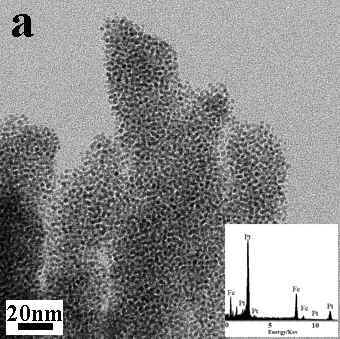
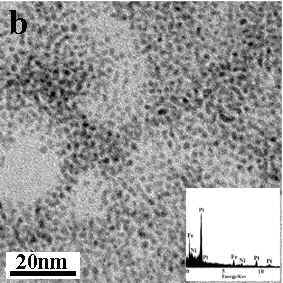
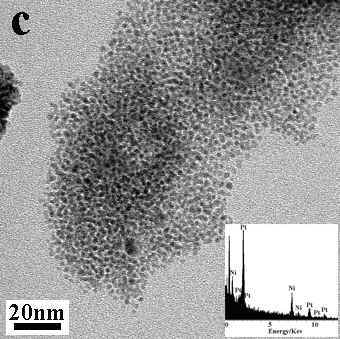
Fig. 1TEM images and EDS Spectra of Fe52Pt48(a) Fe41Ni12Pt47 (b) and Ni54Pt46 (c)
Fig.2 shows XRD patterns of series of as-synthesized platinum nanoalloys and annealed ones at 823K under argon for 1h. The as-synthesis plantinium alloy nanoparticles are chemical disordered fcc structure (Fig.2a1b1c1). Annealing treatment induce the phase transfer to L10 (fct phase), confirmed by XRD in Fig.2a2b2c2, as indicated by the (111) and (200) peak shift and evolution of the (001), (110), (201), (220) and (311) peaks.
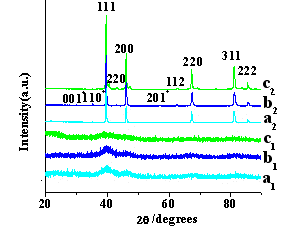
Fig.2. XRD patterns of nanoproducts of Fe52Pt48, Fe41Ni12Pt47 and Ni54Pt46: (a1)(b1)(c1) as-synthesized;
(a2)(b2)(c 2) annealed at 823K under argon for 1h.
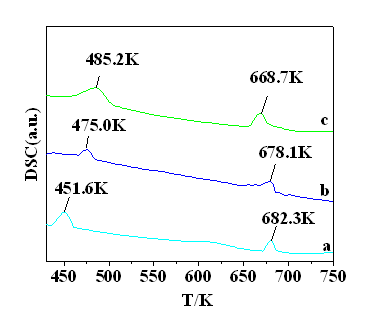
Fig. 3. DSC curves: (a) Fe52Pt48; (b)Fe41Ni12Pt47; (c) Ni54Pt46.
We summarized the mechanism as follows.
Three phases formed in system: sodium oleate (solid), the liquid phase of ethanol and
oleic acid (liquid), and the water-ethanol solution containing transition metal ions
(solution). The phase transfer of Mn+ occurred spontaneously across the
interface between solid sodium oleate and ethanol solution based on Mn+ and Na+
exchange. At the designated temperature, the propylene glycol in the liquid phases reduced
the metal ions at the liquid-solid interfaces. Thus, the platinium alloy nanoparticles
could be obtained at the bottom of the container. All as-synthesized nanoalloys have
disorder structures. Annealing induced the phase transformation to chemically ordered fct
phase.
3.2 Thermal stability
In the interesting of the kinetic ordering temperature, the nanoproducts were
characterized by DSC (Fig.3). There are two exothermic peaks at 451.6K and 682.3K for Fe52Pt48,
475.0K and 678.1K for Fe41Ni12Pt47, 485.2K and 668.7 K
for Ni54Pt46. For a given Pt content, with the Ni content
increasing, the kinetic ordering temperature of A1 phase shift to high
temperature field in the order of Fe52Pt48(Fig.3a)<Fe41Ni12Pt47 (Fig.3b)<Ni54Pt46 (Fig.3c), and of L10
phase shift to low temperature field in the reverse order of Fe52Pt48(Fig.3a)>Fe41Ni12Pt47 (Fig.3b)>Ni54Pt46 (Fig.3c). So the additions of Ni in
FePt higher kinetic ordering temperature of A1 phase and lower that of L10
phase. In the ternary FeNiPt alloys[14], because Ni atoms are approximately the
same size as Fe atoms, a size argument is not sufficient to explain the observed behavior.
Therefore, a chemical content must also contribute to the activation energy. In FeNiPt, it
exhibits substantial decreases in the activation energy for even small additions of Ni. So
the addition of Ni acts to accelerate the L10 phase transformation,
which does not agree with the previous reported[14].
3.3 Magnetic properties
The Hc of as-obtainzed Fe52Pt48, Fe41Ni12Pt47
and Ni54Pt46 are 60Oe, 830Oe and 1900Oe, respectively. After
annealed, the Hc are changed to 4218Oe for Fe52Pt48, 2450Oe
for Fe41Ni12Pt47, 228Oe for Ni54Pt46(
Table.1). Interestingly, the magnetism of as-synthesized nanoalloys changed from
paramagnetic with Hc of 60Oe to ferromagnetic with Hc of 1900Oe as Ni
content varied from 0at.% to 54at.%, but the variation trend of Hc of annealed ones
are inverse case, Hc decrease from 4218Oe (ferromagnetic) to 228Oe (paramagnetic).
Sample No. |
S1 |
S2 |
S3 |
|
Alloy content(at.%) |
Fe52Pt48 |
Fe41Ni12Pt47 |
Ni54Pt46 |
|
Hc(Oe) |
a |
60 |
830 |
1900 |
b |
4218 |
2450 |
228 |
|
4. CONCLUSIONS
Three monodispersed platinium alloys nanoparticles with the size of 2-4 nm were
synthesised through the reduction of Fe2(C2O4)3·5H2O,
NiCl2·6H2O and H2PtCl6·6H2O
by a propylene glycol in the solvothermal system. The additions of Ni lower L10
kinetic ordering temperature in Fe-Ni-Pt. Magnetic specificity indicated that
as-synthesized nanoalloys changed from paramagnetic to ferromagnetic as Ni content
increase, but the annealed ones are inverse case.
REFERENCES
[1] Sun S.H., Anders S., Thomson T., et al. J. Phys. Chem. B, 2003, 107 : 5419.
[2] Teng X.W., Yang H., J. Am. Chem. Soc., 2003, 25: 14559.
[3] Sun S., Murray C.B., Weller D., et al. Science, 2000, 287: 1989.
[4] Stahl B., et al. Phys. Rev. B., 2003, 67: 014422.
[5] Liu C., et al. J. Phys. Chem. B., 2004, 108: 6121.
[6] O'connor C.J., CarpenterV.E., Sangregorio C., et al. Synth. Met., 2001, 122.
[7] Paduani C., J. Appl. Phys., 2001, 90: 6251.
[8] Roucoux A., Schulz J., Patin H., Chem. ReV. 2002, 102:,3757.
[9] Casado-Rivera E., Volpe D. J., Alden L., et al. J. Am. Chem. Soc., 2004, 126: 4043.
[10] Lopez M. F., Escudero M. L., Electrochim. Acta, 1998, 43: 671.
[11] Zhang Z. T., Blom D. A., Gai Z., et al. J. Am. Chem. Soc., 2003, 125(25): 7528;
[12] Wang Y., Yang, H. J. Am. Chem. Soc., 2005, 127 (15): 5316.
[13] Li Y., Zhang X.L., Qiu R., et al. J. Phys. Chem. C ., 2007, 111: 10747.
[14] Berrya D. C., Barmak K., J. Appl. Phys., 2007, 102: 024912.
[15] Wang X., Zhuang J., Peng Q., Li Y.D., Nature. 2005, 437: 121.
铂合金纳米粒子的溶剂热合成与磁性研究
(同济大学化学系,上海 200092)
摘要 通过相转移溶剂热法合成出粒径为2-4nm的三种Pt合金纳米粒子。通过HRTEM,EDS,XRD,DSC和VSM对合成的合金纳米粒子进行了表征。结果显示,Ni的添加降低了FeNiPt体系的有序化转变温度。随着Ni含量的增加,合金纳米粒子从顺磁性(60Oe)转变为铁磁性(1900Oe),但是回火后磁性的变化趋势正好相反,矫顽力从4218Oe减小到228Oe。
关键词 相转移溶剂热法,Pt合金纳米粒子,磁性